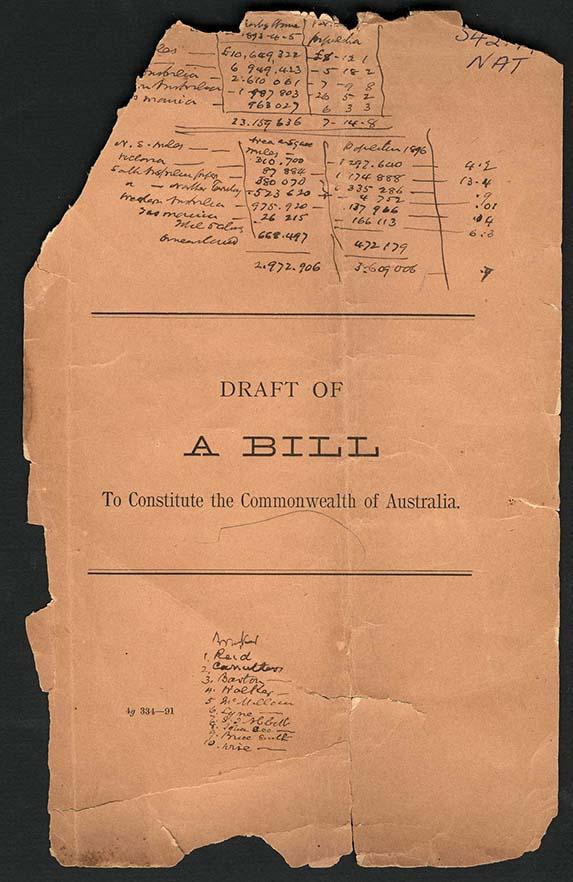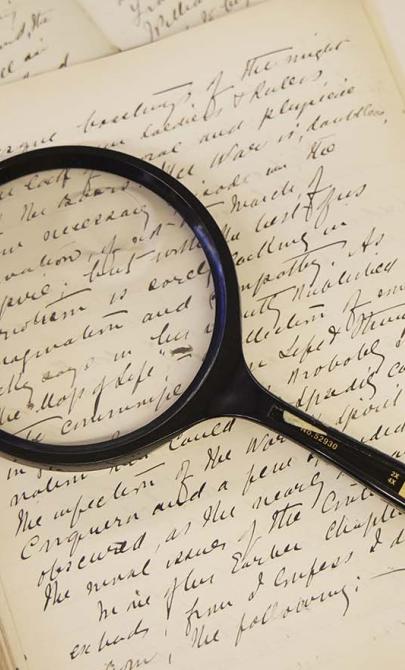Documenting Federation
The Papers of Sir Edmund Barton
The Papers of Sir Edmund Barton include personal documents and records, diaries, newspaper cuttings and other items relating to Barton’s private and professional life.
One of the most significant items in the collection is a copy of the 1891 draft of a bill to constitute the Commonwealth of Australia. Barton had three copies of this document in his papers; one is especially important because it contains Barton’s handwritten annotations.

Sir Edmund Barton, Papers of Sir Edmund Barton, 1827-1940, nla.gov.au/nla.obj-225140407
Sir Edmund Barton, Papers of Sir Edmund Barton, 1827-1940, nla.gov.au/nla.obj-225140407
Learning activities
Activity 1: Exploring the Constitution
Ask students some preparatory questions:
- Who or what decides the laws and rules in our classroom?
- What would our classroom be like if we did not have rules?
- Who or what decides the laws and rules in our society?
- What would our society be like if we did not have established laws and rules?
With your class, brainstorm ideas about what a constitution is. Provide background about the formation of the Australian Constitution and the need for a document establishing the basis of our democratic society.
Activity 2: Exploring Barton’s draft bill
Show students the online digitised copy of Barton’s constitutional draft bill. Read aloud the opening lines of the preamble (the first paragraph of the draft bill), drawing attention to the words within brackets:
WHEREAS the Australasian colonies of [here name the colonies which have adopted the Constitution] have by [here describe the mode by which the assent of the Colonies has been expressed] agreed to unite in one Federal Commonwealth under the Crown of the United Kingdom of Great Britain and Ireland
Then read the final version of this wording from the Commonwealth of Australia Constitution Act
Whereas the people of New South Wales, Victoria, South Australia, Queensland, and Tasmania, humbly relying on the blessing of Almighty God, have agreed to unite in one indissoluble Federal Commonwealth under the Crown of the United Kingdom of Great Britain and Ireland
Activity 3: Investigating Australian states and territories
Using a classroom map of Australia, ask students to identify which state is not included in the final preamble. Then divide the class into three teams for a 20-minute online or in-library investigation:
- Team 1: Why was Western Australia not included in the list of states?
- Team 2: When did the Northern Territory come into being?
- Team 3: What were the reasons for the creation of the Australian Capital Territory?
After 20 minutes, teams report their findings to the class. (Note: other parts of the final Constitution do include Western Australia.)
Activity 4: Reflecting on Barton’s draft
Use the following questions to explore the context of Barton’s draft document:
- What makes this item a treasure?
- What important political office did Barton later hold? Who succeeded him?
- What important judicial office did Barton later occupy?
- Why was a draft important for finalising the Australian Constitution?
- The draft constitution bill was annotated by Barton in 1891. How many years passed before Australian Federation?
Draw students’ attention to the handwritten notes on page 12 of Barton’s draft. Barton noted the possibility of a deadlock between the House of Representatives and the Senate. One major issue during the drafting was resolving legislative deadlocks. This concern resulted in Section 57 of the final Constitution, which has been activated six times since coming into effect. This process is called a double dissolution.
Activity 5: Further research activity
Ask students to research:
- Section 57 of the Australian Constitution
- The meaning of a double dissolution
- The events of the 1974 double dissolution and the dismissal of the Whitlam government in 1975



